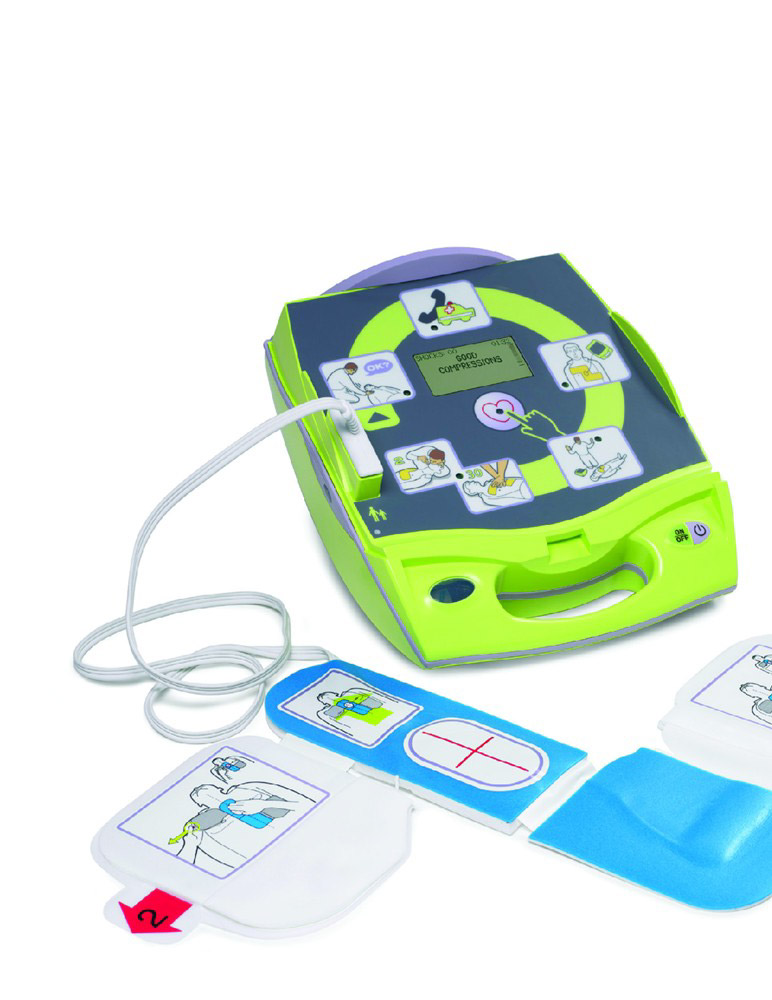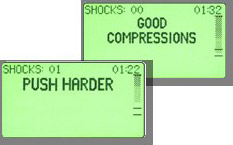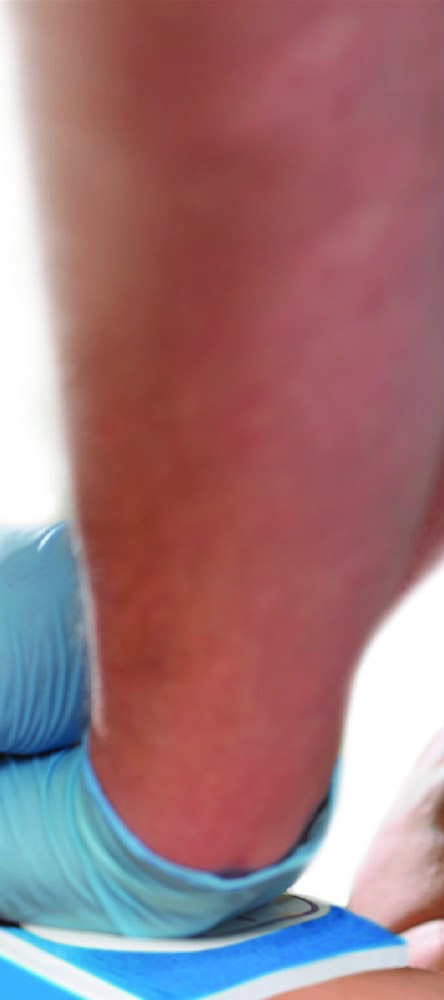Zoll AED Plus
The Best Support For RescuersCPR Required
The latest American Heart Association (AHA) Guidelines issued in 2010, are clear: successful
defibrillation requires high-quality CPR performed at the proper depth and rate. When it’s time
for CPR, the AED Plus® with Real CPR Help® provides the best support to help save a life.

The CPR hand-placement landmark contains a sensor that detects and measures chest compressions.
Whether a shock is advised or not, the 2010 Guidelines say that rescuers should focus on delivering high-quality CPR.1 If no shock is advised, only high-quality CPR can potentially save a victim. That’s because only good CPR can restore the heart rhythm to one required for a shock to work.
Even when an AED says “Shock Advised,” high-quality CPR should begin immediately after shock delivery. Once shocked, the heart struggles for blood as it tries to reorganize and restore its natural beat. By moving blood through the heart, and back into the heart muscles themselves, CPR provides critical help to the struggling heart. Without this help, a shock alone may prove ineffective, and the victim may not be resuscitated.

Audio prompts match the displayed text.

Knowledge Is Power
The AHA’s 2010 Guidelines recommend that rescuers push hard to a depth of at least 2 inches (or 5 cm) at a rate of at least 100 compressions per minute. But how do you know you’re reaching that depth and rate? You shouldn’t have to guess—you should know.
Only an AED that offers real-time CPR feedback provides the best support for saving a life.
“Rescuers should focus on delivering high-quality CPR: providing chest compressions …of at least 2 inches.”
– 2010 AHA Guidelines, p. S678
An AED that Helps You Perform High-Quality CPR
Only ZOLL’s AED Plus is equipped with Real CPR Help technology. The sensor in the pads lets the AED see each chest compression and lets you know how you’re doing. It guides you, with prompts and a real-time bar gauge, to the recommended depth and rate of compressions.
The Only Fully Compliant AED
The AED Plus fully complies with the AHA’s 2010 Guidelines because it is the only AED with a Food and Drug Administration (FDA)-approved therapy that lets you know when compressions are at least two inches deep. ZOLL updated its Real CPR Help technology to comply with the new Guidelines for compression depth during CPR, reflecting the increase from 1ó to 2 inches to at least 2 inches. This modification constituted a change in therapy that necessitated FDA approval.
No other AED on the market required this type of update or approval.
“CPR can double or triple survival from witnessed cardiac arrest.”
– 2010 AHA Guidelines, p. S706
How It Works
• The CPR-D-padz® electrode senses and reports the motion of the chest compressions to the AED Plus.
• Audio and text prompts relay compression quality.
• The compression depth bar gauge lets you see the depth of each compression in real time.
• The adaptive metronome detects compression rate and guides you to at least 100 per minute.

The compression depth bar gauge helps you to achieve the recommended depth of at least two inches.
What It Means to See
Because the AED Plus can “see” your compressions, you can see, hear, and read how well you are performing CPR.
|
RESCUER ACTIONS |
AED PLUS SUPPORT |
|
Not yet started? |
“START CPR” |
|
Stopped? |
“CONTINUE CPR” |
|
Too slow? |
Adaptive metronome speeds you up |
|
Not deep enough? |
“PUSH HARDER” |
|
Performing good CPR? |
“GOOD COMPRESSIONS” |
|
Want to see how |
Visible bar gauge indicates depth of compressions |
THE CASE
FOR AEDs
Survival Increases with Early Intervention
Research shows that the probability of survival goes up dramatically when CPR is performed, and when an AED is applied before an ambulance arrives.*

Probability of Survival
(Discharge from hospital and alive 30 days later)
Where is the AED?
Too often, the answer is, “We don’t have one.” Sadly, the same research that demonstrated a nearly fivefold increase in survivability (from 5% to 24%) when an AED is used, also showed that an AED is available only 2% of the time.
* Weisfeldt ML, et al. J Am Coll Cardiol. 2010;55(16):1713-20.
Real CPR Help Really Works
In the largest hospital caregiver study, research proved conclusively that Real CPR Help significantly increases the quality of chest compressions.2
Hospital caregivers had their chest compressions measured first without any help and then again with Real CPR Help from an AED Plus. Of all compressions delivered without any help, only 15 percent reached the proper depth and rate.
However, when these same caregivers were tested with Real CPR help, 78 percent of their compressions were in target—a fivefold increase in CPR quality.
“Several studies have demonstrated improvement in chest compression rate [and] depth… when real-time feedback or prompt devices are used to guide CPR performance.”
“…real-time CPR prompting and feedback technology such as visual and auditory prompting devices can improve the quality of CPR (Class IIa, LOE B).”
– 2010 AHA Guidelines, p. S697
The Benefits of Ownership
The AED Plus can help your organization’s bottom line. Once installed, the AED Plus has the lowest total cost of ownership of all AEDs on the market, especially when considering the logistics of tracking and changing pads and batteries over the life of the AED.
Thanks to the long shelf life of the consumables, when you compare the cost of maintenance over 10 years, this AED is the most cost-effective unit to own. The AED Plus is powered by lithium batteries (available from retail outlets) that last five years, and the CPR-D-padz last five years as well.

THE CASE FOR CPR
Quality Buys Time
The AHA’s 2010 Guidelines note that if bystanders do nothing for a collapsed victim, the chance of survival drops about 10% every minute.
Probability of Survival (no CPR)*

Minutes Since Collapse
But if bystanders can immediately begin CPR and keep it up, then the chance of survival only drops 3% to 4% per minute. At that rate, approximately 10 minutes after collapse, the chance of survival remains at least 60%.
Probability of Survival (with CPR)*

Minutes Since Collapse
*Source:2010 AHA Guidelines for CPR and ECC. Circulation. 2010;122:S
The Best Support
No other AED supports a rescuer as thoroughly as the AED Plus because it includes the following:
• A one-piece CPR-D-padz electrode for quick, easy application. Pull-tabs expose the conductive gel on each pad only when it is in direct contact with the skin, limiting the chance of gel contamination.
• A rescue accessory package attached to every CPR-D-padz that contains items critical to a successful rescue.
• A lid that acts as a “passive airway support” to maintain the victim’s open airway.
• A back-lit display screen that provides simultaneous text with every audio prompt, and a circle of lighted graphical icons that show what to do.
• A display screen that presents the elapsed time and number of shocks delivered, critical information needed by EMS personnel when they arrive.
• Real CPR Help. No other AED can see the rescuers chest compressions and guide them to the required depth and rate. Other AEDs make you guess when your compressions are deep enough. Only the AED Plus lets you know.
References:
1 2010 American Heart Association Guidelines for Cardiopulmonary Resuscitation and Emergency
Cardiovascular Care Science. Circulation. 2010;122:S678.
2 Peberdy MA, et al. Resuscitation. 2009;80(10):1169-74.
Download in PDF
AED Plus Press.pdf